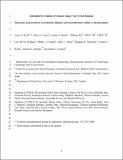Atmospheric evolution of volcanic smog ("vog") from Kılauea: Real-time measurements of oxidation, dilution, and neutralization within a volcanic plume
Author(s)
Wallace, Lisa M. M.; Croteau, Philip L.; Jayne, John T.; Worsnop, Douglas R.; Heald, Colette L.; Murphy, Jennifer G.; Frankel, Sheila L.; Kroll, Jesse; Cross, Eben Spencer; Hunter, James; Pai, Sidhant J.; ... Show more Show less
DownloadKroll_Atmospheric evolution.pdf (1.223Mb)
PUBLISHER_POLICY
Publisher Policy
Article is made available in accordance with the publisher's policy and may be subject to US copyright law. Please refer to the publisher's site for terms of use.
Alternative title
Atmospheric Evolution of Sulfur Emissions from Kilauea: Real-Time Measurements of Oxidation, Dilution, and Neutralization within a Volcanic Plume
Terms of use
Metadata
Show full item recordAbstract
The high atmospheric concentrations of toxic gases, particulate matter, and acids in the areas immediately surrounding volcanoes can have negative impacts on human and ecological health. To better understand the atmospheric fate of volcanogenic emissions in the near field (in the first few hours after emission), we have carried out real-time measurements of key chemical components of the volcanic plume from Kılauea on the Island of Hawai‘i. Measurements were made at two locations, one ∼3 km north-northeast of the vent and the other 31 km to the southwest, with sampling at each site spanning a range of meteorological conditions and volcanic influence. Instrumentation included a sulfur dioxide monitor and an Aerosol Chemical Speciation Monitor, allowing for a measurement of the partitioning between the two major sulfur species (gas-phase SO[subscript 2] and particulate sulfate) every 5 min. During trade wind conditions, which sent the plume toward the southwest site, sulfur partitioning exhibited a clear diurnal pattern, indicating photochemical oxidation of SO[subscript 2] to sulfate; this enabled the quantitative determination of plume age (5 h) and instantaneous SO[subscript 2] oxidation rate (2.4 × 10[superscript –6] s[superscript –1] at solar noon). Under stagnant conditions near the crater, the extent of SO[subscript 2] oxidation was substantially higher, suggesting faster oxidation. The particles within the plume were extremely acidic, with pH values (controlled largely by ambient relative humidity) as low as −0.8 and strong acidity (controlled largely by absolute sulfate levels) up to 2200 nmol/m[superscript 3]. The high variability of sulfur partitioning and particle composition underscores the chemically dynamic nature of volcanic plumes, which may have important implications for human and ecological health.
Date issued
2015-03Department
Massachusetts Institute of Technology. Department of Civil and Environmental Engineering; Massachusetts Institute of Technology. Department of Materials Science and EngineeringJournal
Environmental Science & Technology
Publisher
American Chemical Society (ACS)
Citation
Kroll, Jesse H., Eben S. Cross, James F. Hunter, Sidhant Pai, Lisa M. M. Wallace, Philip L. Croteau, John T. Jayne, et al. “Atmospheric Evolution of Sulfur Emissions from Kı̅lauea: Real-Time Measurements of Oxidation, Dilution, and Neutralization Within a Volcanic Plume.” Environ. Sci. Technol. 49, no. 7 (April 7, 2015): 4129–4137.
Version: Author's final manuscript
ISSN
0013-936X
1520-5851